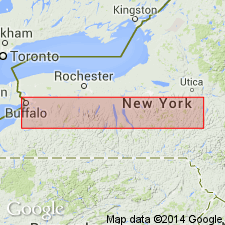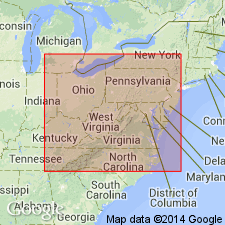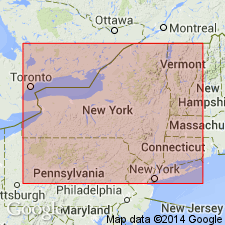
- Usage in publication:
-
- Cherry Valley limestone
- Modifications:
-
- Areal extent
- AAPG geologic province:
-
- Appalachian basin
Summary:
Pg. 131-132. Applied Union Springs member to basal beds of Marcellus shale, separating Cherry Valley limestone from underlying Onondaga limestone. [Age is Middle Devonian.]
Source: US geologic names lexicon (USGS Bull. 896, p. 419).

- Usage in publication:
-
- Cherry Valley Limestone Member*
- Modifications:
-
- Areal extent
- AAPG geologic province:
-
- Appalachian basin
Summary:
Cherry Valley Limestone Member of Marcellus Shale extended from southwestern NY into western PA, and into the subsurface in northern WV and westernmost MD (Garrett Co.).
Source: GNU records (USGS DDS-6; Reston GNULEX).

- Usage in publication:
-
- Cherry Valley Member
- Modifications:
-
- Revised
- AAPG geologic province:
-
- Appalachian basin
Summary:
Marcellus Formation will be "formally" raised to subgroup status within the Hamilton Group and be divided into a lower Union Springs Formation and an upper Mount Marion Formation (in eastern New York), and an upper Oatka Creek Formation (in central and western New York), in a publication by Ver Straeten and others (in prep). Union Springs Formation will incorporate three members across New York: the Bakoven Member (geographically extended across the State of New York), the Stony Hollow Member (restricted), and the Hurley Member (new). The Hurley underlies the Cherry Valley Member at the base of the laterally equivalent Mount Marion and Oatka Creek Formations. By extending the Cherry Valley across the state, it now includes strata formerly assigned to the upper part of the Stony Hollow Member. The revised Cherry Valley is composed of two lithosomes; an eastern sand-dominated facies and a central to western carbonate-dominated facies. Strata above the Cherry Valley in the Oatka Creek remain unnamed, though they bear some resemblance to the Chittenango Shale Member of the Mount Marion Formation of west-central New York.
["Subgroup" not recognized as a formal stratigraphic rank term (CSN, 1933; ACSN, 1961, 1970; NACSN, 1983, 2005, 2021). Considered informal and should not be capitalized.]
Source: Modified from GNU records (USGS DDS-6; Reston GNULEX).
For more information, please contact Nancy Stamm, Geologic Names Committee Secretary.
Asterisk (*) indicates published by U.S. Geological Survey authors.
"No current usage" (†) implies that a name has been abandoned or has fallen into disuse. Former usage and, if known, replacement name given in parentheses ( ).
Slash (/) indicates name conflicts with nomenclatural guidelines (CSN, 1933; ACSN, 1961, 1970; NACSN, 1983, 2005, 2021). May be explained within brackets ([ ]).

